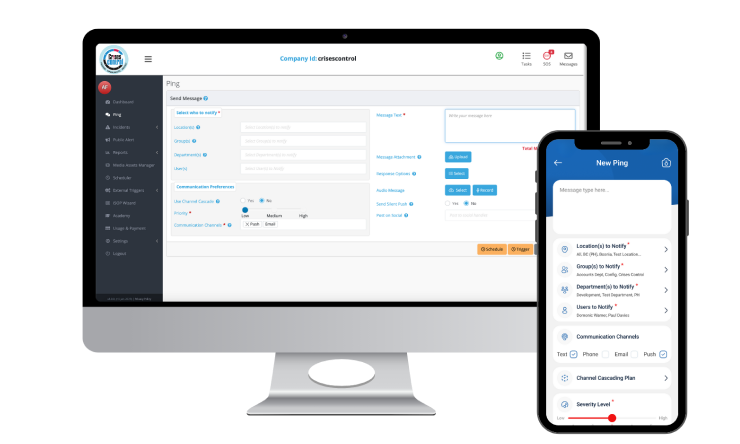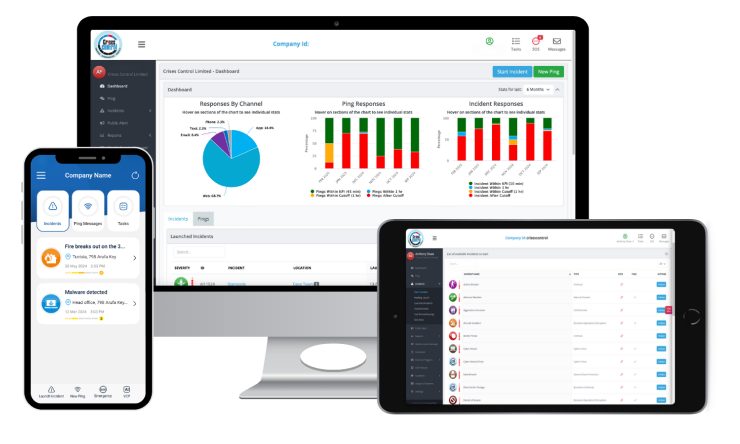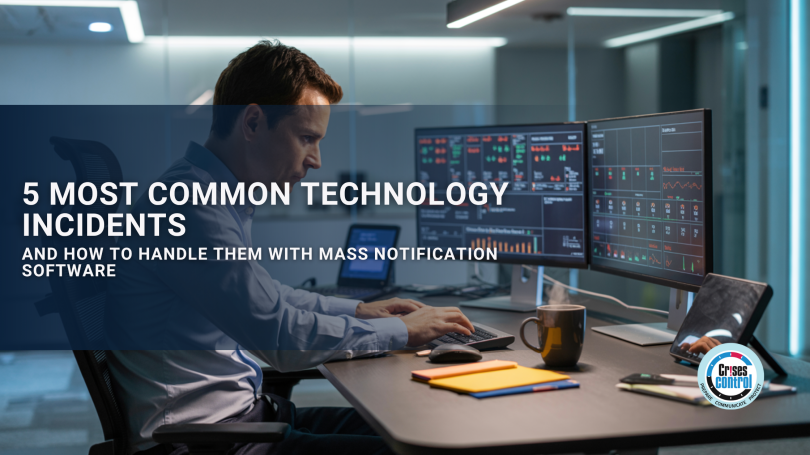Written by Anneri Fourie | Crises Control Executive
A single outage or cyberattack can ripple through a technology company in minutes. Systems fail, customers lose access, teams scramble for answers, and leadership demands quick decisions. When communication is slow or uncoordinated, what could have been contained often turns into a full-blown business crisis.
Fast and structured communication is one of the simplest ways to keep incidents from escalating. This is where mass notification software plays a key role. It helps teams share accurate information instantly, coordinate tasks, and reduce downtime while maintaining control.
This article looks at five common incidents that technology companies face and how structured communication can turn a chaotic moment into a managed event.
Why Fast Incident Communication Protects Technology Companies
Technology companies run on trust, uptime and reliable access. When something breaks, even a short delay can have a long impact.
When communication falters in the early minutes of an incident, the consequences can multiply. Teams miss alerts, customers lose patience, and regulators start asking questions. Common risks include:
- Loss of revenue from service interruptions or missed transactions
- SLA penalties and financial hits
- Damaged reputation and reduced customer confidence
- Compliance issues if reporting obligations are missed
- Delayed recovery and operational slowdowns
Using mass notification software for technology companies can remove many of these weak points. With one trigger, the right people receive the right information, escalation is clear, and leadership has real-time visibility of what is happening.
1. Cyberattacks and Ransomware Incidents
A well-timed cyberattack can bring even the most advanced systems to a standstill. Ransomware or unauthorised access can compromise services, expose sensitive data and disrupt operations in seconds.
Many companies lose critical time during the first minutes of an attack. Alerts get lost in crowded inboxes, security teams are not fully informed, and leadership often learns of the problem too late. This early confusion can increase costs and extend downtime.
How Crises Control can help:
- Trigger instant alerts to security, IT, legal and leadership teams.
- Launch predefined response templates to remove delays.
- Share consistent, controlled messages with customers and regulators.
- Keep a full log of actions for reporting and post-incident analysis.
By using real-time alerting for tech company incidents, teams can respond fast, contain the attack and protect critical systems before the situation spreads.
2. Data Breaches and Information Leaks
A data breach is more than a technical failure. It affects reputation, legal obligations and customer trust. Technology companies often operate under strict regulations such as GDPR, NIS2 or CIRCIA, which require timely reporting and evidence of response.
Delays in communication during a breach can make regulatory exposure far worse. When messages don’t reach the right people quickly, investigation and containment are delayed.
How Crises Control can help:
- Send immediate alerts to data protection, legal and communications teams.
- Use escalation paths to ensure no critical notification is missed.
- Coordinate messaging to regulators, clients and partners with consistency.
- Keep detailed communication records for audits and compliance.
Fast, structured communication during a data breach builds trust and keeps the organisation aligned with legal requirements.
3. Service and Platform Outages
For SaaS providers and infrastructure operators, uptime is more than a KPI. It is their reputation. Even a short platform outage can mean lost revenue, customer churn and contractual penalties.
Traditional communication tools like group emails or chat platforms are often too slow. They can’t guarantee that the right team members see the alert or that updates are shared quickly with customers.
How Crises Control can help:
- Send alerts to internal teams across multiple channels at once.
- Provide automatic service status updates to customers and partners.
- Allow responders to acknowledge alerts, escalate tasks and track progress in one place.
- Reduce Mean Time to Resolution (MTTR) through automated workflows.
By reducing downtime with alerting software, incidents can be contained and services restored without confusion or delays.
4. Insider Threats and Unauthorised Access
Not all incidents come from outside the organisation. Insider threats, either deliberate or accidental, can disrupt critical operations and lead to regulatory scrutiny.
Detecting and containing these incidents quickly is essential. Manual communication often slows everything down, which gives the issue more time to grow.
How Crises Control can help:
- Send targeted alerts to security and HR teams for fast containment.
- Launch preconfigured playbooks for internal security incidents.
- Track every action and keep leadership informed in real time.
- Support investigations with a clear communication history.
With structured notifications and predefined response actions, internal threats can be managed quietly and effectively.
5. Major Infrastructure Failures
Infrastructure failures can affect entire regions or service areas. Whether it’s a data centre outage, a networking issue or a third-party service collapse, these incidents can hit fast and hard.
They often require a coordinated response between multiple teams and partners. Slow or fragmented communication during these moments can make everything worse.
How Crises Control can help:
- Alert technical teams immediately, even if internal systems are affected.
- Coordinate distributed teams to diagnose and resolve the issue quickly.
- Keep customers informed with clear and consistent updates.
- Give leadership visibility of incident progress and decisions.
Mass notification capabilities help technology companies respond at speed and keep operational control when infrastructure is at risk.
Interested in our Ping Mass Notification Software?
Efficiently alert everyone in seconds at scale with our Mass Notification Software.

Why Manual Communication Processes Are Not Enough
Many technology companies still rely on manual processes such as email chains, messaging apps or static escalation trees. These can work for minor disruptions but fall short during serious incidents.
Manual communication often leads to:
- Delayed or missed messages
- Confusion over ownership of critical tasks
- Gaps in reporting and compliance records
- Slower response and longer downtime
Imagine a key alert arriving in an inbox during off-hours. By the time the right person sees it, the incident has already grown. Automated alerts and structured workflows remove this risk and keep teams aligned from the start.
How Crises Control Helps Technology Companies Respond Faster
Crises Control was built to support organisations that can’t afford delays during incidents. For technology companies, it combines speed, structure and visibility in one platform.
Key capabilities include:
- Multi-channel notifications: Messages sent by SMS, email, voice and push alerts reach the right people fast.
- Automated workflows: Predefined playbooks guide teams through common incidents like outages or cyberattacks.
- Incident dashboard: Real-time visibility of acknowledgements, actions and incident progress.
- Compliance support: Automatic logging creates a complete audit trail.
- Integrations: Alerts can be triggered from existing monitoring and security systems.
These capabilities allow teams to act confidently, shorten resolution times and protect their reputation.
Building a Culture of Incident Preparedness
Incident response is not just about technology. It’s about people knowing their roles and having the right processes in place. Companies that handle disruptions well often:
- Run regular drills to test response times
- Keep incident playbooks current and relevant
- Encourage clear communication between technical and leadership teams
- Integrate compliance requirements into their response plans
Crises Control supports this by making communication simple and reliable when it matters most. Teams can focus on resolving the issue rather than chasing updates or wondering who is responsible.
Why Investing in Mass Notification Software Protects Your Business
Technology companies face constant risk from outages, breaches and cyberattacks. These incidents can’t always be prevented, but their impact can be managed.
Mass notification tools give organisations the structure to respond fast and reduce damage. Clear communication builds confidence with customers, regulators and teams.
Investing in the right system protects revenue, reputation and operational stability.
Take Control of Your Incident Response
Technology incidents can’t always be predicted, but their impact can be controlled. By combining automated workflows with real-time alerts, technology companies can take decisive action during their most critical moments.
Crises Control gives organisations the tools to keep communication clear, teams aligned and operations steady when it matters most.
If your company wants to reduce downtime and strengthen its response to incidents, book a free demo to see how Crises Control can help your team stay in control.
Request a FREE Demo

